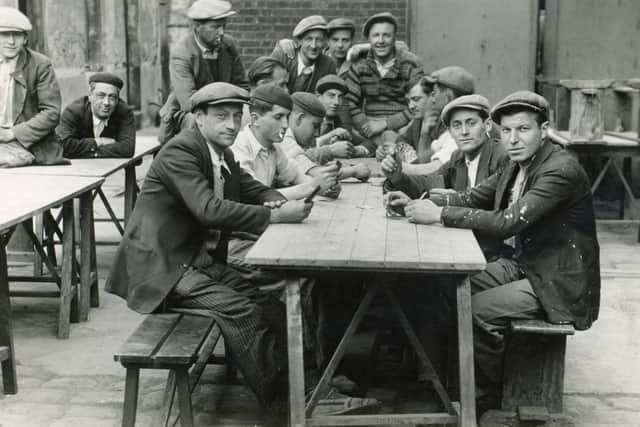Mystery of striking photographs solved after nearly a century
It is an evocative set of photographs that has eluded explanation for the best part of a century. The images capture scores of French workers downing tools as they fight for better pay.
In one, a man plays an accordion, while his colleague, gesturing at the camera, holds a half empty bottle of wine. Another captures a group of men crowded around a handwritten sign. It reads: “Ninth day of strike. Morale excellent. We swear to fight to the end.”
Advertisement
Hide AdAdvertisement
Hide AdFor years, the pictures have been in the collection of the OnFife cultural charity, yet the French connection to Scotland has proved a mystery. Now, however, a new exhibition can reveal the details of the men and their industrial action, while also shedding light on the global reach of the area’s once thriving linoleum industry.
Until recently, all that was known about the set of photographs is that they were taken at a French linoleum factory, but as part of a new exhibition exploring the history of Fife’s linoleum trade, curator Lily Barnes decided to try to find answers.
She knew that, by the end of the 19th century, the industry was thriving, with major Kirkcaldy producers such as Michael Nairn and Company, and Barry, Ostlere and Shepherd, operating multiple factories. The majority were clustered in Kirkcaldy, the so-called linoleum capital of the world, but business was so brisk that the producers also turned overseas for help.
Ms Barnes, who is overseeing the Flooring the World exhibition, which opens at Kirkcaldy Galleries on 15 November, decided to turn her attention to the Bibliothèque National de France, the French national library in Paris. Based on the type of clothing worn by the men in the photographs, she searched through the collection’s early 20th century online archives. While the majority of the material was simply newspaper advertisements for linoleum, one publication, L’Humanité, which served as the official journal of the French Communist party, turned up an intriguing lead.
Ms Barnes explained: “In an issue dated 7 March 1923, it mentioned a strike at a linoleum factory in Le Houlme, Normandy, operated by a company called La Compagnie Rouennaise de Linoleum (CRL). At the time, Nairn’s and Barry’s were consolidating their power, and we know that Barry, Ostlere and Shepherd was officially formed in 1899 by a merger. There was ,however, a fourth company included in its DNA – the little Normandy venture.”


CRL was formed in 1897, but became part of Barry’s, headquartered in Kirkcaldy, two years later. At the time, it employed around 150 people, but at its peak, the workforce stood at approximately 500. While the precise date of their strike – which centred around winter pay – remains as yet unknown, further research by Ms Barnes suggests that the factory’s connections with Fife was in itself a source of grievance.
“A report in our collection written in the 1950s by one of Barry’s managers, noted that the French factory often had to make do with out-of-date equipment,” she explained.
“When new machines were purchased, these were prioritised for Kirkcaldy who then sent their cast-offs to Normandy. It is possible that the feeling that the French factory was something of an afterthought may have been present in the 1920s, and contributed to the feeling of discontent among the workers.”
Comments
Want to join the conversation? Please or to comment on this article.